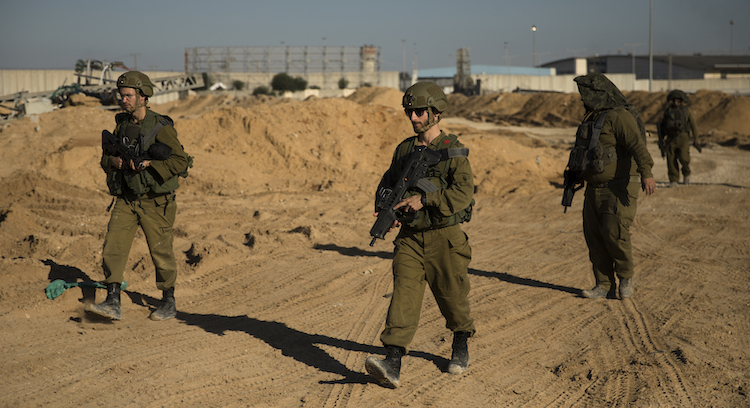It’s fun to imagine what the Israel-Gaza discourse would sound like if the world could be sane for a minute or two. If instead of obsessing over Israel in a quest to brand the Jewish state with the scarlet letter, observers and commentators and activists could think through the complexities on the ground and look for actual solutions to existing problems.
For example, let’s take the issue on everybody’s mind: humanitarian aid. There are two stories today that, taken together, help us visualize what a productive conversation might achieve.
The first is an open letter signed by a couple hundred nonprofits, most of them Jewish, defending the Gaza Humanitarian Foundation. But the letter is notable not because of its defense of GHF but because of its wording and tone.
The online publication eJewishPhilanthropy, which has the text of the letter, says it“specifically calls for the United Nations and world leaders to oppose attempts to ‘obstruct or delegitimize’ the GHF’s work [and] advocates for coordination between the GHF and the U.N. to be formalized.”
This follows an interview the publication conducted with Yotam Politzer, the CEO of IsraAid, an Israeli humanitarian group that had been quietly operating in Gaza. Politzer didn’t have much to say about the GHF, with which he is unaffiliated. But he did tell eJP that “the only way forward is if we get everyone involved, and I mean everyone, I mean the Israeli government, the IDF, the U.N., the GHF, the NGOs, the Gulf countries.”
Meanwhile, as the letter-writers suggest, it’s especially bad form to obstruct the work of a different aid organization. It’s also, frankly, dangerous to delegitimize other groups. The demonization of the GHF no doubt contributes to an atmosphere in which its already perilous work becomes more so: GHF workers have been attacked, and its attempts to distribute food have been disrupted by violence and by misinformation designed to trick Palestinians into going to the wrong locations for aid, which puts Palestinian lives in danger.
The second story is a thoughtful essay by Michael Starr at the Jerusalem Post. Starr has served several tours in Gaza during the war and written honestly about what he has seen and experienced. Today, Starr writes that much of his third tour was spent securing the area around distribution sites in southern Gaza.
Regarding the question of famine, Starr writes: “I did not see mass starvation in Gaza. Of the tens of thousands of civilians, there was no one close to the emaciated state of hostage Evyatar David.” But neither is it true that all Gazans live like the ones we’ve seen on Instagram, well-fed and carefree. Plenty of Gazans “live in unfortunate states, and the neediest among the internally displaced are desperate, facing malnutrition and even prolonged hunger.”
Regarding the aid sites themselves, Starr’s essay is well worth reading in full. Soldiers trained for warfare had to adapt to policing strategies with enemy forces, in civilian clothing, still hunting them. The IDF suddenly had a mission of preventing humanitarian disaster while also defeating Hamas, which meant not letting Hamas get hold of the aid that they were simultaneously trying to provide civilians. Nevertheless, Starr writes, “The stories told by some of the more malicious news outlets about Palestinians being shot while peacefully queuing are ludicrous not only because live-fire warning shots were only employed on the extremely rare occasion that Gazans in the aid site yard deviated toward the closed military zone that was out of their way, but also because I never once saw anything resembling a line or queue.”
Instead, “the sites are controlled chaos, with Palestinian aid seekers constantly seeking to overrun the compound, save for the intervention of armed security contractors.” Those contractors would “use stun grenades to warn off belligerent men who attempt to enter the site in situations like when there are special distributions for women or children. Palestinian aid workers have also used mace to repel aid seekers who refused to leave the site.”
Because some items were more valuable on the market than others, Palestinians would set up literal trading posts off to the side of the distribution site. At the end of the day, Gazans were told to stay behind specific concrete roadside barriers to prevent the area from being overrun day and night. Still, many secretly dug trenches in the area and tried to sleep there. There was violence and theft between aid recipients, and a general atmosphere of fear and panic induced partly by Hamas’s threats against the aid seekers and the proliferating stories about the chaos.
Terrorists did mix in among the aid seekers: Starr recalls one throwing a grenade, another stabbing a soldier. At all times, the possibility of a stampede loomed; a crowd crush could kill and injure aid seekers and perhaps even overrun the security around the site. Soldiers used warning shots, which does hold some risk—but so does not firing any warning shots in many of the situations.
“Yet despite all the problems,” Starr writes, “people were getting fed by the SDS sites, and they appreciated it.” Some “Gazan aid seekers were waving, blowing kisses, and performing heart signs with their hands as they left. People in a ‘killing field’ wouldn’t act like that.”
It turns out well-meaning people are doing their best, which is still imperfect. Human, you might say. The narrative one hears from the Western press is far from the reality. A hearty dose of sanity would do everyone some good—and get more Gazans fed, too.
















